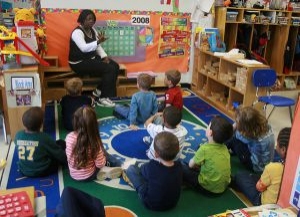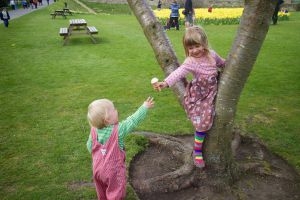Social Constructivist Theory in Early Childhood Education is a learning approach grounded in the idea that children actively construct knowledge through their social interactions and cultural experiences. Rather than viewing learning as an individual process of acquiring information, social constructivism emphasizes that children build understanding through communication, collaboration, and shared experiences. The following article provides information on Key Concepts, Applications In Early Childhood, Modern Relevance In Childcare and more.
Key Concepts of Social Constructivism in Early Childhood Education
-
Zone of Proximal Development (ZPD)
-
Definition: The ZPD, a concept introduced by Lev Vygotsky, refers to the gap between what a child can accomplish independently and what they can achieve with guidance. In this space, learning is most effective because children receive the necessary support (often called scaffolding) that helps them progress beyond their current abilities.
-
Example: Educators design activities to challenge children just beyond their current competence. For example, during a literacy activity, a teacher might pair a child who can read simple stories with a peer who can help decode more complex words, gradually reducing assistance as the child advances in understanding.
-
-
Scaffolding
-
Definition: Scaffolding is the process where teachers provide temporary, tailored support to help children perform tasks they cannot yet complete independently. This support is gradually removed as children become more confident and capable, allowing them to internalize new skills.
-
Example: In practice, an educator might demonstrate a problem-solving strategy during a math game, then work alongside the children as they try the strategy themselves, stepping back gradually as the children gain confidence.
-
-
Collaborative Learning
-
Definition: Social constructivism places high value on learning that occurs through collaboration. When children work together—whether in pairs or small groups—they exchange ideas, challenge each other’s thinking, and build a shared understanding of concepts.
-
Example: Group projects, interactive games, and guided play sessions enable children to learn from one another. For example, during a group art session, children might discuss and decide together how to represent a story with their art, blending individual creativity with collective input.
-
-
Role of Language and Dialogue
-
Definition: Language is not just a means of communication but a fundamental tool for thinking and learning. Through dialogue, children co-construct knowledge by articulating their ideas, asking questions, and reflecting on new experiences.
-
Example: Educators encourage discussions during activities, such as circle time or story-sharing sessions, where children explain their understanding of a concept or narrate experiences, thereby refining their thoughts and learning from peers.
-
Applications in Early Childhood Education
-
Learning Through Play: Play remains one of the most natural and engaging methods through which young children learn. Educators can structure play-based activities that require cooperation and communication. For instance, in imaginative play scenarios, children might assume roles (such as shopkeeper and customer), negotiating roles and responsibilities, which fosters both social skills and cognitive development.
-
Guided Group Work: By organizing small-group tasks where children solve problems together—be it a puzzle, a building project with blocks, or a group storytelling session—the educator harnesses the power of social interaction. Through these interactions, each child learns by observing and contributing to the group’s collective reasoning.
-
Interactive Dialogues: Regular classroom conversations and reflective discussions, such as asking children what they learned from an activity or how they solved a challenging task, reinforce the idea that knowledge is built through dialogue. Teachers can use open-ended questions to prompt deeper thinking and ensure that all voices are heard, strengthening the learning community.
-
Cross-Curricular Connections: Integrating different learning areas (for example, combining science with art) in collaborative projects can further enrich children’s understanding. When children discuss their observations from a science experiment and then illustrate their findings through art, they connect various domains of knowledge, reinforcing both their cognitive and social skills.
Criticism & Limitations
Social Constructivist Theory has significantly shaped early childhood education by emphasizing the importance of social interactions and culturally mediated learning. However, as with any theoretical approach, it is not without criticisms and limitations. Below is an overview of some key points:
1. Overemphasis on Social Interaction
Criticism: Social constructivism underscores the value of collaborative learning and interactions among peers, sometimes at the expense of acknowledging individual learning processes. Critics argue that not all children thrive in highly social environments; children with more introverted tendencies or those with developmental challenges may require individualized attention that structured, collaborative activities might not always provide.
Implications: Educators need to balance group work with opportunities for independent learning, ensuring that activities are flexible enough to accommodate different learning styles and personalities.
2. Ambiguity in Assessment
Criticism: Because social constructivist approaches focus on the process of learning rather than static outcomes, determining and measuring individual progress can be challenging. The emphasis on emergent understanding and fluid knowledge co-construction often makes standardized assessment tools less applicable. Critics contend that this ambiguity may lead to difficulties in documenting and justifying children’s learning achievements in a quantifiable way.
Implications: To overcome this, educators may combine qualitative assessments (like observations and portfolios) with more structured assessment methods to capture both process and content mastery.
3. Cultural and Contextual Limitations
Criticism: Social constructivist theory is grounded in the idea that learning is inherently a social and cultural process, yet this perspective may not translate across all cultural contexts. Critics point out that the model often reflects Western educational values and may not consider the diverse cultural practices and learning preferences found in various global communities. As a result, strategies based solely on this theory might not resonate with every child or community.
Implications: Early childhood educators should adapt and localize collaborative strategies, ensuring that the social context of learning embraces cultural diversity and respects different communicative and interactive styles.
4. Potential for Insufficient Guidance
Criticism: Social constructivist environments often emphasize student-led inquiry and discovery. While this can foster creativity and deeper understanding, critics note that without sufficient scaffolding, some children might struggle to meet developmental milestones. The lack of explicit instruction may leave children confused or unsupported when they face complex learning challenges.
Implications: A balanced approach is essential. Educators should ensure that inquiry-based activities are well supported through purposeful scaffolding, where guidance is progressively withdrawn as competence increases.
5. Classroom Management Challenges
Criticism: Since social constructivism promotes flexible, dynamic, and often unstructured interactions, maintaining classroom order can sometimes be more complicated. The open-ended, exploratory nature of activities might lead to moments of chaos, making it challenging for educators to keep students focused and ensure each learning objective is met.
Implications: To manage this, educators can establish clear routines and rules that allow freedom of exploration while still maintaining a structured environment. This balance helps ensure that the benefits of social learning are achieved without compromising safety or order.
Each of these criticisms reflects important considerations that educators must address when designing early childhood programs. While social constructivist theory provides a rich and supportive framework for collaborative learning, a nuanced approach—one that integrates elements of structure, individualized attention, and culturally sensitive practices—is essential for fostering an inclusive and effective learning environment.
Modern Relevance in Childcare
Modern relevance in childcare reflects how contemporary early childhood settings integrate both traditional theories and innovative practices to support holistic development. In practice, modern childcare environments have evolved to balance structure with flexibility, ensuring that children receive both the guidance they need and the freedom to explore their interests.







 Working as a childcare professional can be a challenge especially when dealing with behavioural problems which may arise. The techniques we use when dealing with
Working as a childcare professional can be a challenge especially when dealing with behavioural problems which may arise. The techniques we use when dealing with There are different types of behaviour that children can display and sometimes it can be hard to manage, especially if a child is having behavioural
There are different types of behaviour that children can display and sometimes it can be hard to manage, especially if a child is having behavioural As a parent, your behavioural expectations of your child can be higher than what is actually developmentally appropriate for your child's age.
As a parent, your behavioural expectations of your child can be higher than what is actually developmentally appropriate for your child's age.
 As Educators, there will be many instances where you will need to write about a child's behaviour. For a behaviour management plan, assessments, half-yearly or
As Educators, there will be many instances where you will need to write about a child's behaviour. For a behaviour management plan, assessments, half-yearly or As Educators when communicating with Parents (through verbal or non-verbal communication), there will be times where we need to discuss issues or concerns that may
As Educators when communicating with Parents (through verbal or non-verbal communication), there will be times where we need to discuss issues or concerns that may Challenging Behaviour is when a child does something that hurts themselves and/or other people.
Challenging Behaviour is when a child does something that hurts themselves and/or other people.
 As part of your child's development it is normal for your child to have anxiety and fears. A baby commonly shows a fearful sign to
As part of your child's development it is normal for your child to have anxiety and fears. A baby commonly shows a fearful sign to It's always difficult to bring up behavioural issues with parents, it can be nerve wrecking to tell a parent that their child misbehaves but that
It's always difficult to bring up behavioural issues with parents, it can be nerve wrecking to tell a parent that their child misbehaves but that All children deal with anger on a daily basis. Thinking about it as a child, there is a lot to be angry about. Elder people
All children deal with anger on a daily basis. Thinking about it as a child, there is a lot to be angry about. Elder people It is important to understand that your child behaviour problems could not just be from attention seeking. There are many factors to take into consideration
It is important to understand that your child behaviour problems could not just be from attention seeking. There are many factors to take into consideration


